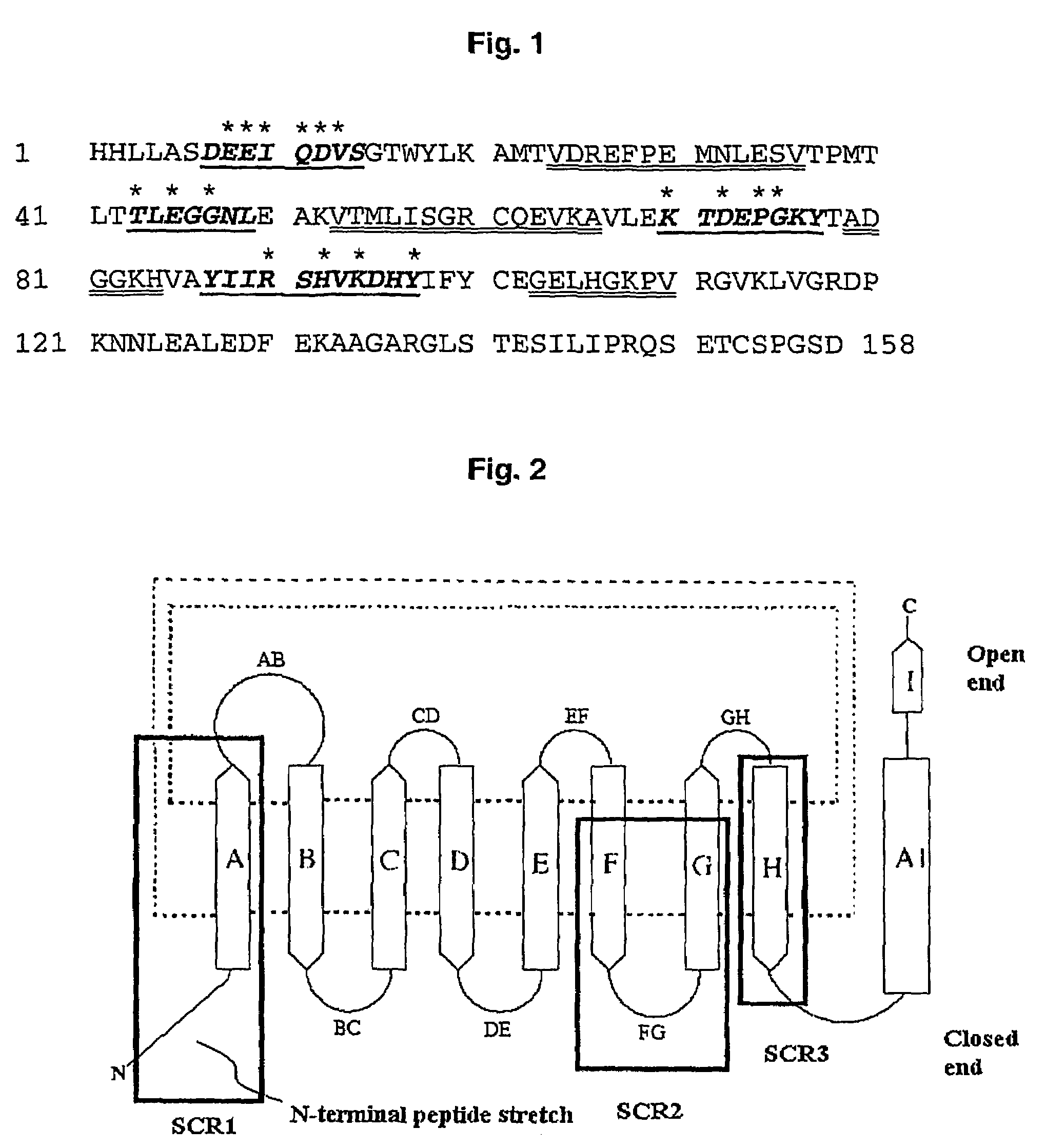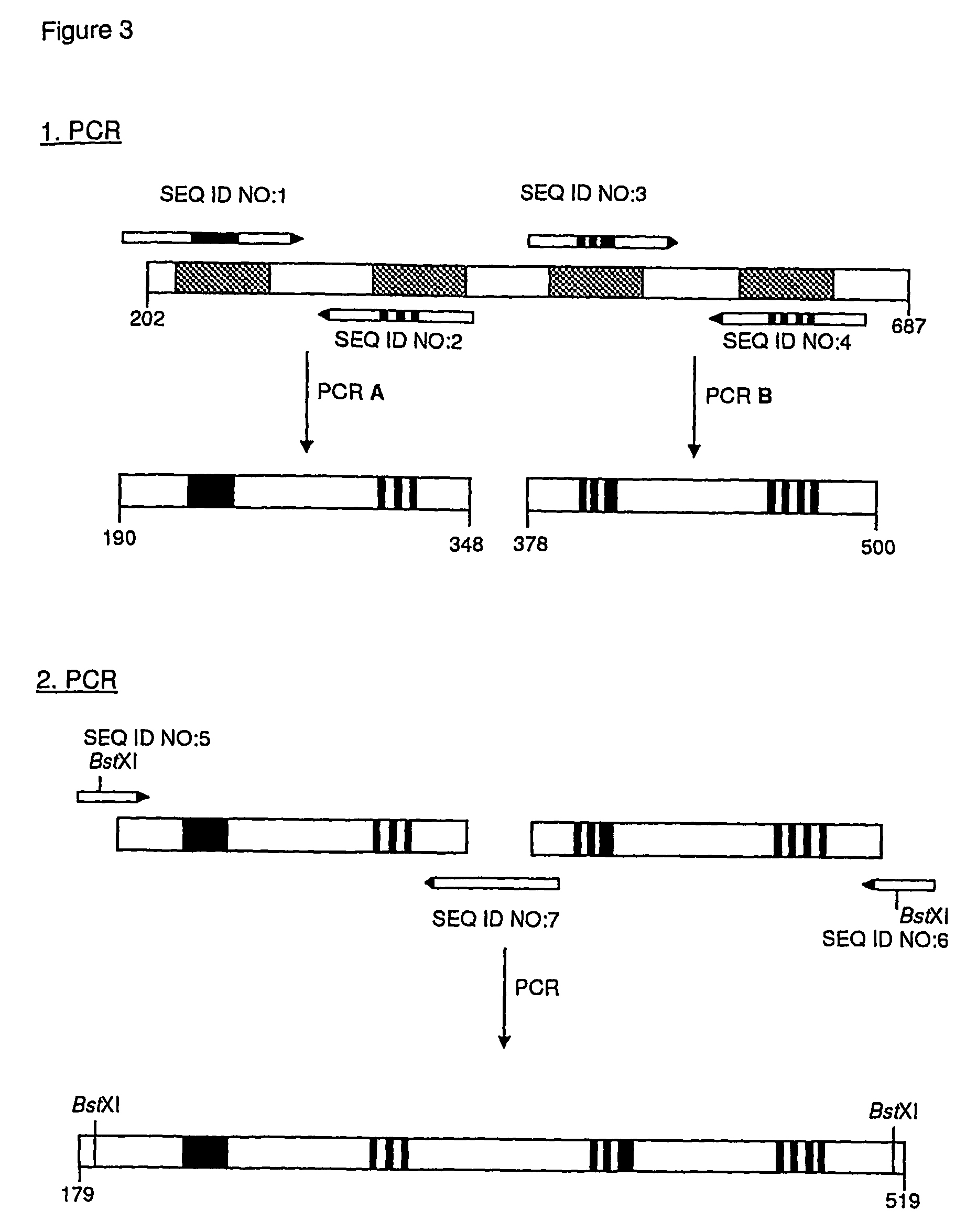Muteins of human tear lipocalin
a technology of lipocalin and mutein, which is applied in the field of muteins and muteins can solve the problems of unclear biological function of human tear lipocalin, affecting the stability of lipocalin, so as to improve the folding efficiency or folding stability of lipocalin mutein, the effect of easy cloning
- Summary
- Abstract
- Description
- Claims
- Application Information
AI Technical Summary
Benefits of technology
Problems solved by technology
Method used
Image
Examples
example 1
Generation of a Library with 10 Billion Independent TLPC Muteins
[0158]Unless otherwise indicated, established recombinant genetic methods were used, for example as described in Sambrook et al. (supra).
[0159]A random library of TLPC with high complexity was prepared by concerted mutagenesis of in total 17 selected amino acid positions near the N-terminus and in the peptide loops BC, DE, and FG using PCR in multiple steps according to FIG. 3. The PCR reactions were performed in a volume of 100 μl in both of the first amplification steps (PCR No. 1, A and B), wherein 10 ng pTLPC6 plasmid-DNA (FIG. 5, SEQ ID NO: 2) was employed as template together with 50 pmol of each pair of primers (SEQ ID NO: 3 and SEQ ID NO: 4 or SEQ ID NO: 5 and SEQ ID NO: 6, respectively), which were synthesized according to the conventional phosphoramidite method. In addition, the reaction mixture contained 10 μl 10×Taq buffer (100 mM Tris / HCl pH 9.0, 500 mM KCl, 15 mM MgCl2, 1% v / v Triton X-100) and 2 μl dNTP-M...
example 2
Generation of a Library with 10 Billion Independent TLPC Muteins
[0166]A second random library of TLPC with high complexity was prepared by concerted mutagenesis of selected amino acid positions in the four peptide loops AB, CD, EF as well as GH encompassing the natural lipocalin binding pocket at the open end of the lipocalin using PCR in multiple steps according to FIG. 6. In loop AB a length variation was introduced by insertion of either two or four amino acids using the same PCR strategy as described in Example 1, but employing two different oligodeoxynucleotides (SEQ ID NO: 27 and SEQ ID NO: 28) for preparation of the fragments from PCR A, comprising six or twelve additional random nucleotides for the insertion of two or four amino acids. In order to stabilize loop AB bearing the four amino acid insertion, the N-terminal and C-terminal anchor positions were fixed by the amino acid substitutions V24W, D25S and M31N, N32S encoded by the oligonucleotide SEQ ID NO: 28. The PCR reac...
example 3
Phagemid Presentation and Selection of TLPC Muteins Against VEGF Employing High Binding Polystyrol Multiwell Plates
[0171]For selection of TLPC muteins, 2×1012 to 1×1013 phagemids of the library obtained in Example 1 were used. In brief, the phagemids were centrifuged (21460×g, 4° C., 20 min) and resuspended in 1 ml PBS (4 mM KH2PO4, 16 mM Na2HPO4, 115 mM NaCl, pH 7.4) containing 50 mM benzamidine. PBS containing 6% w / v bovine serum albumin (BSA; Roth) and 0.3% Tween 20 was used as blocking buffer. Prior to the incubation with the target protein, phagemids from the library were incubated in bovine serum albumine-blocked polystyrol wells 2 times for 15 minutes for the depletion of phagemids representing multi-reactive or misfolded lipocalin mutein. Recombinant human vascular endothelial growth factor (165 aminoacids, rhuVEGF165) produced in insect cells (R&D Systems) was coated on the polystyrole plates with a concentration of 2.5 μg / ml. After incubation of the blocked phagemids in th...
PUM
 Login to View More
Login to View More Abstract
Description
Claims
Application Information
 Login to View More
Login to View More - R&D
- Intellectual Property
- Life Sciences
- Materials
- Tech Scout
- Unparalleled Data Quality
- Higher Quality Content
- 60% Fewer Hallucinations
Browse by: Latest US Patents, China's latest patents, Technical Efficacy Thesaurus, Application Domain, Technology Topic, Popular Technical Reports.
© 2025 PatSnap. All rights reserved.Legal|Privacy policy|Modern Slavery Act Transparency Statement|Sitemap|About US| Contact US: help@patsnap.com



